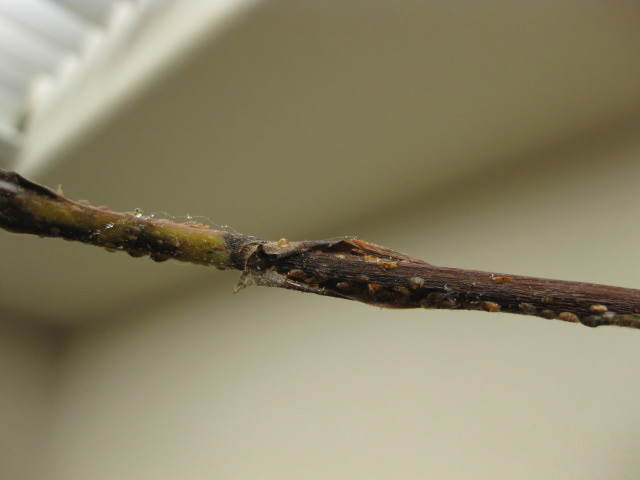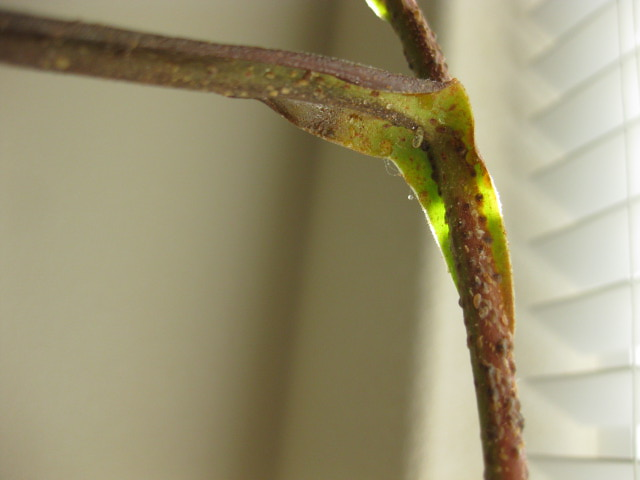Question Turning brown
Turning brown
 Underside of leaf at s
Underside of leaf at s
QUESTION: Hi Jacob!
I have a Poi Dog that has been hanging in a West window with only natural light for just over a year. We keep the house around 73*F year round and it has been doing great - colorful leaves, lots of pitchers, and even has a new shoot springing from the bark at the base of the plant near the soil. It was doing so well that I took a couple of cuttings from it last month. However, it has recently started to brown on the stem and some leaves so I thought it was just starting it's dormancy; but now it looks like there is something growing and spreading quickly on the stem and, when I look closer, it's under the leaves at the stem, but not on the top of the leaves (see photos).
What is this and what should I do?
ANSWER: Hi Portia,
This is a severe scale insect infestation. If it's anywhere near other plants, such as other Nepenthes or Orchids, they are going to have it too. These can be difficult insects to eradicate, so I'm going to recommend a strong solution. What works best on these is Acepahte (Orthene). You have to order it online since it's not available for consumer use anymore in garden centers. Here's a supplier: http://www.domyownpestcontrol.com/acephate-97up-insecticide-p-2751.html
Acephate is a systemic, organophosphate insecticide that will be absorbed by the plant's tissues, and lasts around 30 days. With that powder you mix 1 teaspoon per gallon of water. You would need to take your plants outside, spray them, then let them dry before bringing them back in. Wear gloves, and read any safety precautions on the label. The stuff isn't super poisonous to mammals, but you want to be careful with it. Pouring some into the soil is a good idea too. It kills the insects when they feed on the plant as opposed to contact. It's very effective on scale and thrips, but you'll need to do another treatment a month later to make sure you've got them all. Be sure and treat any other Nepenthes or houseplants you have.
After treatment you should notice dying of the scale in about a week. They start to dry and flake off. Let me know how it goes.
Good Growing!
Jeff Dallas
Sarracenia Northwest
http://www.growcarnivorousplants.com
---------- FOLLOW-UP ----------
QUESTION: Thank you, Jeff!
What generally causes scales? Is this something I did somehow?
Also, should I watch for this on my cuttings as well and what are the first signs of infection?
Thanks again, I really appreciate your help!
AnswerHi Portia,
The usual way you get scale is by bringing in a plant that has them. The bumps on the stems are the adult stage, but they have a crawler stage that is nearly impossible to see with the naked eye. A plant can have them, and you won't neccesarily know it.
On Nepenthes and Orchids, the first thing to look for is leaves that are all of a sudden sticky where they weren't before. This is often the first sign. I always start looking to see if I see any of the adults if I notice a sticky leaf. If I see one, time to treat.
Good Growing!
Jeff Dallas
Sarracenia Northwest
http://www.growcarnivorousplants.com







